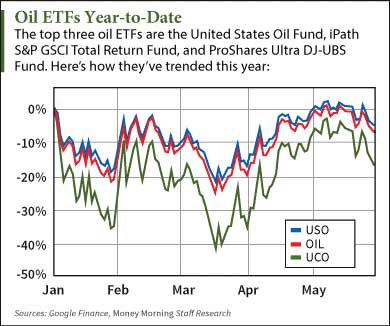Now's a good time to consider crude oil ETF investing to profit from the oil price rebound.
Oil prices have taken a beating this month. WTI has fallen 3.9% since May 1. But the retreat is only temporary.
According to Money Morning's Global Energy Strategist Dr. Kent Moors, prices will climb toward $73 by mid-summer thanks to lower oil supply as oil rigs come offline.
A crude oil ETF is a good option to make money in the oil market when prices are rising. It is less volatile than an oil futures contract because futures are grounded in speculation. Trading futures contracts requires sellers to predict oil prices months in advance, which is incredibly risky. ETFs are safer because they're indirectly exposed to oil prices and less susceptible to their volatility.
But not every crude oil ETF is a great investment. Here's a breakdown of crude oil ETF investing...
What Is a Crude Oil ETF?
A crude oil ETF is an exchange-traded fund that invests in companies engaged in oil discovery, production, distribution, and retail.
 Every crude oil ETF is listed on a stock exchange. They are bought and sold like regular stocks.
Every crude oil ETF is listed on a stock exchange. They are bought and sold like regular stocks.
Oil ETFs typically have higher than average investor demand due to oil's importance to the global economy. You see, almost every product in the world is affected by the price of oil in some way, either as a raw component or through transportation or energy costs. The International Energy Agency (IEA) pegs global oil consumption in 2015 at more than 93 million barrels a day.
Most crude oil ETFs track the performance of indexes that either follow the spot price of oil or a specific group of companies. For example, the S&P Crude Oil Total Return ETF (NYSE Arca: OIL) tracks the S&P's benchmark oil index. Other funds invest in large oilfield services firms like Schlumberger Ltd. (NYSE: SLB) and Halliburton Co. (NYSE: HAL).
Crude oil ETF investing has soared in popularity. According to The Wall Street Journal, roughly $6 billion was poured into oil ETFs in the first quarter alone. That's because the funds offer vast exposure to oil without the hassle and risk of buying futures contracts.
But not all crude oil ETFs are healthy investments. You'll especially want to avoid ETFs that directly deal with volatile futures contracts.
A perfect example is the United States Oil Fund LP (NYSE Arca: USO), the most popular oil ETF on the market. Investors poured more than $2 billion into USO in 2014, and the fund's total assets exceed $3.1 billion.
Despite all the attention, USO is not a good investment during low price periods. Low price periods can cause a problem known as contango - a situation in which futures contracts trade at a higher price than the spot price of oil.
If there is a price gap between the price of the expiring futures contract and the new futures contract, the fund just skips the gap and buys contracts at the higher price. But the investor misses out on those gains. The ETF is only concerned with tracking the price of oil instead of bringing investors the highest possible returns.
Contango can be deadly to ETFs like USO that trade in oil futures. Investors miss out on gains when futures prices are more expensive than the spot price.
That's why we recommend investing in crude oil ETFs focused on the midstream...
The Best Crude Oil ETF to Buy Now
We recommend the First Trust North American Energy Infrastructure Fund (NYSE Arca: EMLP). First Trust holds 68 stocks and primarily invests in midstream master limited partnerships (MLPs).
[epom key="ddec3ef33420ef7c9964a4695c349764" redirect="" sourceid="" imported="false"]
Midstream MLPs aren't as exposed to low oil prices because they derive half of their revenue from pipelines, storage facilities, and other infrastructure. They make money as long as oil keeps flowing. This insulation from the sector's volatility makes them "marketproof" investments.
That's why EMLP is the best crude oil ETF on the market right now. Its portfolio encompasses a wide range of North American MLPs and energy companies.
EMLP became the first actively managed ETF to accrue more than $1 billion in assets. According to Morningstar Inc. (Nasdaq: MORN), it had a one-year total return of 23.83%, the highest out of two dozen "equity energy" ETFs last year.
Not to mention it's benefiting from the biggest MLP merger of 2015...
Energy Transfer Partners LP (NYSE: ETP), one of EMLP's largest holdings, acquired Regency Energy Partners (NYSE: RGP) for $18 billion on April 30. The deal made ETP the second-largest MLP on the market.
EMLP has gained 1% since we first recommended it on March 24 and will continue.
Questions about crude oil ETF investing? Talk to us on Twitter at @AlexMcGuire92 and @moneymorning.
Like us on Facebook: Money Morning
Bonus Content: You can make 2015 your wealthiest year in a few simple moves. You just need to know the three common investing habits to dump immediately, the single most effective strategy for your portfolio, and five stocks to get you started to a wealthier you. Get all of that right now in this exclusive guide...
Related Articles:
- The Wall Street Journal: Money Pours Out of Oil ETFs - Energy Journal


